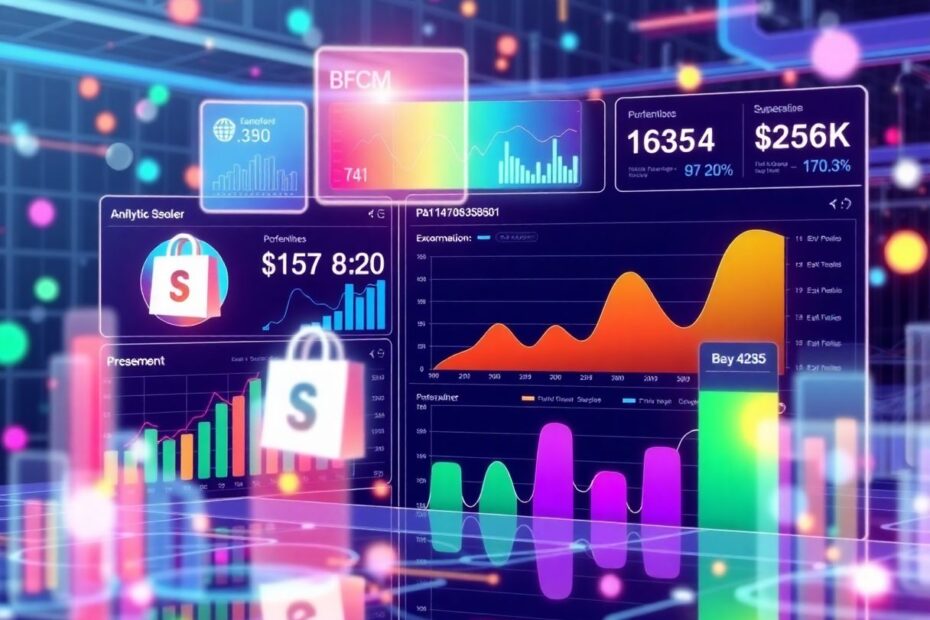As we approach Black Friday Cyber Monday (BFCM) 2025, e-commerce businesses face an ever-evolving landscape of opportunities and challenges. This comprehensive guide will show you how to harness the power of Shopify Analytics to plan, execute, and maximize your success during this high-stakes shopping season.
Understanding the BFCM Landscape in 2025
The e-commerce climate continues to evolve rapidly. In 2022, Shopify merchants generated $7.5 billion in sales during BFCM. Projections for 2025 indicate a potential 30% increase in overall BFCM sales compared to previous years. However, this growth comes with increased competition and changing consumer behaviors.
Key trends shaping BFCM 2025 include:
- Heightened focus on sustainability
- Increased mobile shopping
- Rise of social commerce
- Emphasis on personalized shopping experiences
Setting the Stage with Shopify Analytics
Defining Your Goals and Targets
Review Historical Data: Use the comparison periods feature in your Analytics overview dashboard.
Identify Key Metrics:
- Total sales
- Conversion rate
- Average order value (AOV)
- Customer acquisition cost (CAC)
- Return on ad spend (ROAS)
Set Realistic Targets: Aim for a 20-25% increase in total sales from your last BFCM, considering projected market growth.
Conducting a Business Health Check
Analyze Overall Performance: Review your Analytics overview dashboard.
Evaluate Key Metrics:
- Store conversion rate
- Average order value
- Customer lifetime value (CLV)
Identify Areas for Improvement: Compare to industry benchmarks and historical data.
Inventory Management and Product Analysis
Conduct an ABC Analysis: Categorize products as top performers (A), mid-range sellers (B), and slow-moving items (C).
Analyze Sell-Through Rates: Use inventory reports to predict stock levels.
Review Days of Inventory: Plan reorder points to avoid stockouts.
Optimize Your Product Mix: Decide on promotion strategies for different product categories.
Advanced Strategies for BFCM 2025
Leveraging Predictive Analytics
Demand Forecasting: Use Shopify's predictive demand feature.
Customer Segmentation: Utilize the customer insights report for targeted marketing.
Personalized Recommendations: Implement the product recommendation engine.
Optimizing Your Mobile Experience
With mobile commerce expected to account for over 70% of e-commerce sales by 2025:
Mobile Conversion Rate: Compare mobile vs. desktop conversion rates in the device report.
Page Load Times: Monitor the speed report to ensure fast mobile performance.
Mobile-Specific Promotions: Create and track mobile-only offers.
Harnessing the Power of Social Commerce
Track Social Sales: Monitor the sales by social channel report.
Optimize Content: Use the social engagement report to improve conversion rates.
Influencer Impact: Use UTM parameters to track influencer performance.
Implementing Dynamic Pricing Strategies
Price Sensitivity Analysis: Analyze historical data to understand price-demand relationships.
Competitor Price Tracking: Integrate third-party tools for competitive analysis.
Time-Based Pricing: Implement and track time-sensitive deals.
Measuring and Iterating During BFCM
Real-Time Performance Tracking
Set Up Custom Alerts: Create alerts for significant changes in key metrics.
Monitor Traffic Sources: Adjust ad spend based on channel performance.
Track Inventory Levels: Use real-time inventory tracking to avoid overselling.
Agile Campaign Adjustments
A/B Testing: Optimize email subject lines, landing pages, and other elements.
Promotion Performance: Monitor and adjust promotions based on real-time data.
Customer Feedback Loop: Implement and act on real-time customer feedback.
Post-BFCM Analysis and Future Planning
Comprehensive Performance Review: Compare BFCM performance against initial goals.
Customer Retention Analysis: Examine new vs. returning customer ratios.
Inventory Reconciliation: Use final inventory data to inform future purchasing.
Channel Effectiveness: Analyze ROI across marketing channels.
Year-Over-Year Comparison: Identify long-term trends and improvement areas.
Conclusion: Your Data-Driven Path to BFCM Success
Shopify Analytics is an invaluable tool for planning, executing, and analyzing your BFCM strategy. By leveraging data effectively, you can make informed decisions that drive real results.
Key takeaways:
- Start planning early, using historical data as your guide
- Create a seamless, personalized shopping experience across all devices
- Leverage predictive analytics to anticipate trends and demands
- Be prepared to make data-driven decisions in real-time
- Conduct thorough post-BFCM analysis for continuous improvement
With Shopify Analytics as your compass, you're well-equipped to navigate BFCM 2025 and achieve your most successful shopping season yet.
